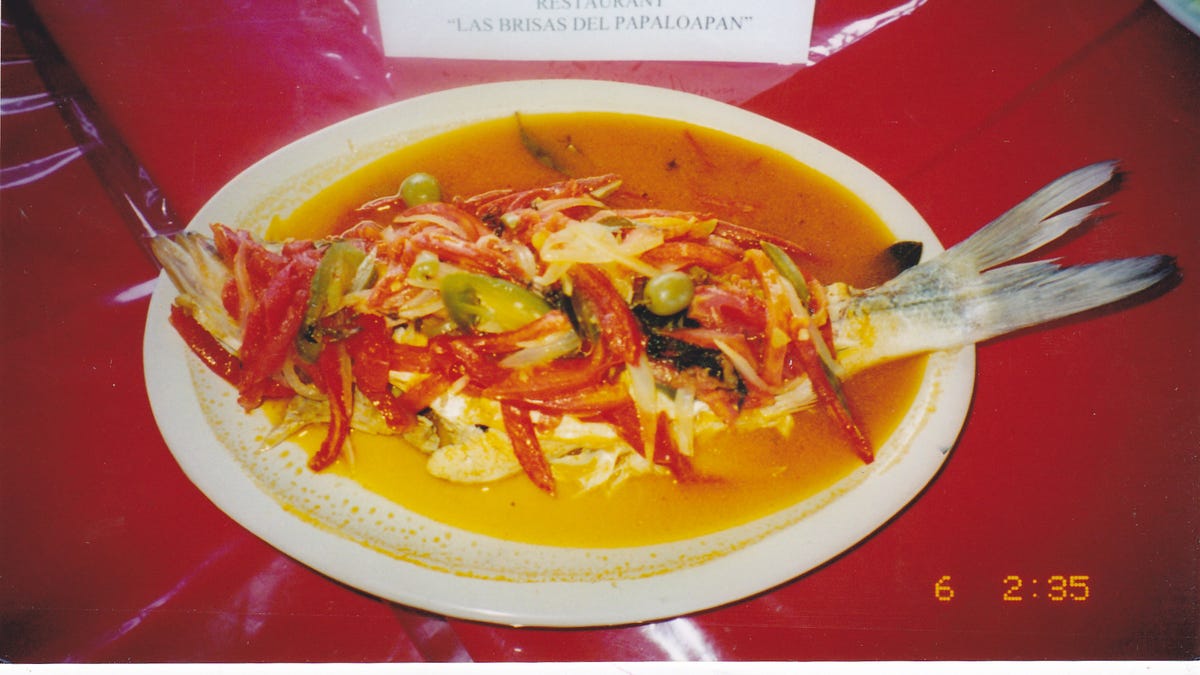
Makes 4 servings
Food-lovers who know nothing else about Veracruzan cuisine probably have heard of the sauce used here through a dish served in restaurants from Mexico to Manhattan: huachinango a la veracruzana, or red snapper topped with a medley of onion, tomatoes, garlic, capers, pickled chiles, pimiento-stuffed green olives, and some combination of herbs, all gloriously redolent of olive oil. Actually, people in Veracruz don’t stop at red snapper; they use any suitable firm-fleshed fish steaks or whole fish and call the dish pescado a la veracruzana.
The sauce (sometimes also enriched with potatoes) is equally popular served with chicken, and I’ve encountered it with poached beef tongue. At my restaurant in New York I experimented still further, using it as a sauce with fried squid. We also used it as a pasta sauce for staff meals
Versions of salsa a la veracruzana range from thin to thick, fussy to minimalist. This one comes from La Sopa Restaurant in Xalapa, where owner/chef Pepe Ochoa has been known to serve his salsa a la veracruzana with canned tuna in empanadas.
Ingredients:
One whole 3-pound fish such as red snapper, grouper, sea bass, or Pacific rockfish, scaled and gutted, gills removed
3 –4 cups of Salsa Veracruzana (recipe below)
1 – 1 1/2 kosher or other coarse salt
1/2 cup olive oil
3 bay leaves and sprigs of thyme (optional)
For Salsa Veracuzana:
1/4 cup olive oil
5 garlic cloves (3 whole, 2 minced)
1 medium-sized white onion, chopped fine
4 - 5 large ripe tomatoes (about 2 pounds), chopped fine, or one 28-ounce can of Italian plum tomatoes with juice, coarsely chopped
1 teaspoon capers (about 12 - 15 large or 24 - 30 small ones)
12 small pimiento-stuffed green olives
2 - 3 pickled jalapeño chiles, stemmed, seeded, and cut lengthwise into thin strips
2 bay leaves
1/4 cup parsley leaves
2 sprigs of fresh thyme or 1/4 teaspoon crumbled dried thyme
2 sprigs of fresh marjoram or 1/4 teaspoon crumbled dried marjoram
2 sprigs of fresh Mexican oregano or 1/4 teaspoon crumbled dried Mexican oregano
1 teaspoon salt, or to taste
1/4 teaspoon ground canela (see page 000)
1/2 cup dry white wine
To make the sauce:
In a heavy-bottomed medium-sized saucepan with a well-fitting lid, heat the olive oil to rippling over medium-high heat. Add the 3 whole garlic cloves and cook, stirring, until deep golden (but not browned) on all sides; remove and discard. Add the 2 minced garlic cloves and the chopped onion. Cook, stirring frequently, until the onion is translucent, about 3 minutes. Stir in the tomatoes. Reduce the heat to medium-low and cook, stirring occasionally for 15 minutes or until slightly concentrated. Add all the remaining ingredients and cook, covered, for another 15 - 20 minutes, until the flavors are richly melded and it is as thick as you like. Taste for salt and add another pinch or two if desired (the capers and olives will contribute some). If using whole fresh herbs, fish them out of the sauce and discard before serving.
Sauce can be made ahead of time and stored.
For the fish:
Preheat the oven to 425
Rinse the fish thoroughly, inside and out, under cold running water, being sure to remove all traces of blood and gills. Blot thoroughly dry, inside and out. Lightly sprinkle the skin and cavity with coarse salt. If desired, place 3 bay leaves and some fresh thyme sprigs inside.
Rub the fish with olive oil and lay it in a roasting pan large enough for it to lie flat. Sprinkle well with oil, note how thick the fish is at its thickest point. Add 2 cups or more of warm sauce to cover the fish. (If the sauce was made beforehand, simmer to heat.) Put fish into the oven. Roast for about 10 minutes per inch (2.5 cm) of thickness; the fish will be done when the eyes are completely white and the flesh near the back bone is no longer translucent but flakes easily when prodded with a toothpick. You will probably want to turn the fish (gently) once about half way through the roasting time.
Serve with more sauce on the side if desired.
Recipe adapted from "Zarela's Veracruz: Mexico's Simplest Cuisine." Zarela Martinez blogs at Zarela.com. You can also check out her how-to videos on YouTube.
Follow us on twitter.com/foxnewslatino
Like us at facebook.com/foxnewslatino
